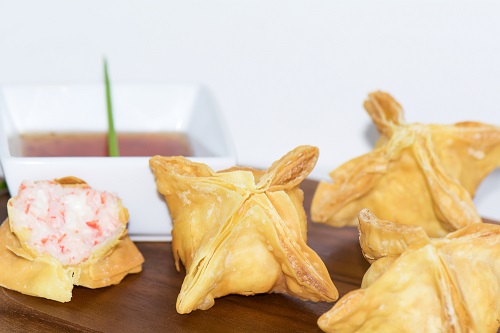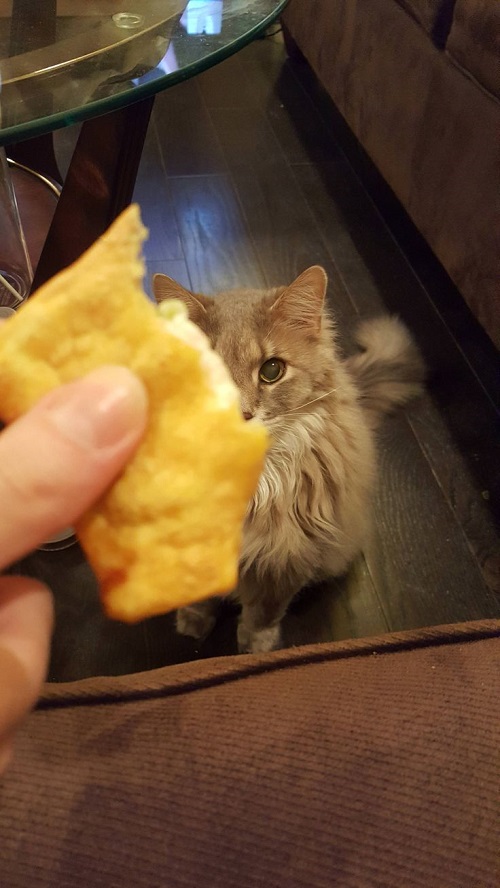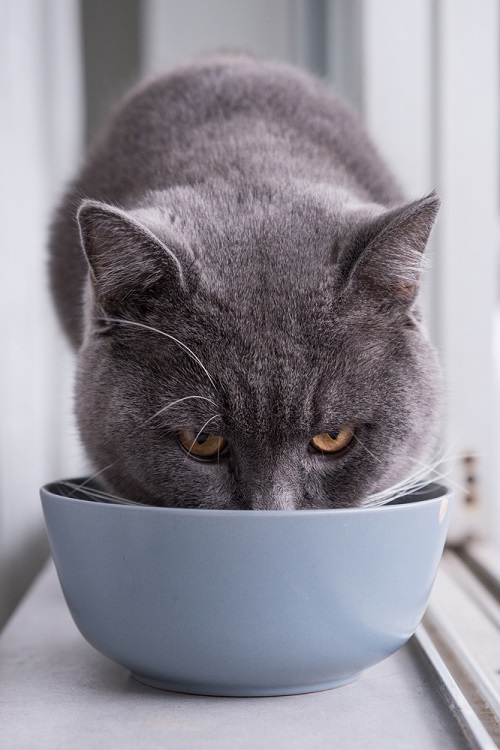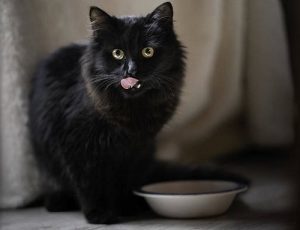Crab Rangoon – a scrumptious treat for humans, but what about felines? Can Cats Have Crab Rangoon? Let’s find out below.
Crab Rangoon – a perfect blend of crab meat and cream cheese nestled in a crispy wonton wrapper. It’s a treat that’s hard for anyone to resist, even our furry friends. But can cats have Crab Rangoon? This is a question that needs some serious consideration, and we’re here to help.
Can Cats Eat Grits? Find out here
What is Crab Rangoon?

Crab rangoon is a popular appetizer in American Chinese cuisine. The combination of the crispy shell and the savory filling creates a delightful contrast of textures and flavors. Although its origins are unclear, crab rangoon has become a beloved dish in many Chinese restaurants. Restaurants often serve crab rangoon with sweet and sour sauce or plum sauce for dipping.
Ingredients Used in Crab Rangoon
Everyone has their own way of preparing this dish, but the common ingredients are as follows:
- Wonton wrappers: Thin sheets of dough made from flour, water, and sometimes eggs, used to encase the filling.
- Cream cheese: A smooth and creamy cheese that serves as the base for the filling. It also provides a rich and indulgent texture.
- Crab meat: Typically, lump crab meat is used, which adds a delicate and sweet seafood flavor to the filling.
- Scallions: Also known as green onions, these provide a fresh and slightly onion-like taste to enhance the overall flavor profile.
- Garlic: Often minced or finely chopped, garlic adds a savory and aromatic element to the filling.
- Soy sauce: A staple in Asian cuisine, soy sauce contributes a salty and umami taste to the filling.
- Salt and pepper: These basic seasonings help to balance and enhance the overall taste of the crab rangoon.
- Vegetable oil: Used for deep frying the crab rangoon to achieve a crispy and golden-brown exterior.
Can Cats Have Crab Rangoon?

Cats are primarily carnivorous, and their diet should consist of balanced and species-appropriate cat food. Feeding cats crab rangoon or any human food is generally not recommended. Crab rangoon contains ingredients such as cream cheese, garlic, and seasonings. These may not be suitable for cats and could potentially cause digestive issues or other health problems.
Is Crab Rangoon Nutritious for Cats?
Crab rangoon lacks nutritional balance for kitties. It primarily consists of cream cheese and other seasonings that are unsuitable for feline consumption, despite containing some protein-rich ingredients like crab meat. Cats have specific dietary requirements. Therefore, specially formulated cat food is the best way to meet their nutritional needs. Feeding crab rangoon can lead to imbalances in their nutritional intake. It may also lead to weight gain or nutrient deficiencies.
Risks of Crab Rangoon for Cats
Feeding crab rangoon to cats poses several risks and potential health issues, such as:
- Digestive issues: The rich and fatty cream cheese used in crab rangoon can be challenging for cats to digest properly. This can lead to stomach upset and other digestive issues.
- Seasonings and spices: Many seasonings and spices used in crab rangoon, such as garlic and onions, can be toxic to cats in large quantities. These ingredients can cause gastrointestinal irritation.
- High salt content: Crab rangoon often contains soy sauce or other salty ingredients, which are harmful to cats. Felines have a low tolerance for sodium, and excessive salt intake can lead to dehydration and electrolyte imbalances.
- Unbalanced nutrition: Crab rangoon is not nutritionally balanced for felines. It lacks essential nutrients that cats need for optimal health.
- Obesity: The high fat and calorie content of crab rangoon can contribute to weight gain and obesity in kitties.
- Allergies or sensitivities: Felines can develop allergies or sensitivities to certain ingredients found in crab rangoon. For example, crab meat or dairy products like cream cheese. These can lead to allergic reactions or skin problems.
Are Cats Attracted to Crab Rangoon?
While individual cat preferences can vary, crab rangoon generally does not attract kitties. The strong scent and flavors of seasonings and spices used in the dish may pique their curiosity, but cats primarily rely on their natural instincts and dietary preferences. Since cats are obligate carnivores, their attraction is more likely toward meat-based foods.
How to Make Crab Rangoon For Cats?
Here’s a step-by-step guide on how to make a cat-friendly version of crab rangoon:
Ingredients:
- Cooked and shredded chicken or fish
- Plain, unsweetened yogurt or a small portion of plain, low-fat cream cheese
- Small, baked, or lightly toasted pieces of bread or cat-friendly alternatives like cat treats
Instructions:
- In a mixing bowl, combine the cooked and shredded chicken or fish with a small amount of plain, unsweetened yogurt or a small portion of plain, low-fat cream cheese. The ratio can be adjusted based on your cat’s preferences and dietary needs.
- Mix the ingredients well until they form a creamy filling. Ensure that there are no bones or skin in the mixture.
- Spoon a small amount of the filling onto a small, baked, or lightly toasted piece of bread or a cat-friendly alternative like a cat treat. You can shape the filling into a small ball or flatten it slightly.
- Offer the prepared Crab Rangoon treat to your cat in moderation. Monitor their reaction and ensure that it is well-tolerated and enjoyed.
- Store any remaining treats in an airtight container in the refrigerator for future use. Use them within a few days to maintain freshness.
How to Feed Crab Rangoon to Cats?

Experts generally do not recommend feeding cats Crab Rangoon due to the potential risks and lack of nutritional value it presents. However, if you still wish to offer a small taste as an occasional treat, it is essential to do so with caution. Remove any seasonings, spices, or excess salt from the filling, ensuring it contains only plain crab meat. Remove the fried wonton wrapper, as it can be difficult for cats to digest. Offer an extremely small amount, about the size of a pea, and closely observe your cat’s reaction and any potential adverse effects.
Symptoms of Crab Rangoon Allergy in Cats
Symptoms of illness in cats due to eating Crab Rangoon can vary depending on the specific ingredients and any potential reactions or toxicity. Here are some common symptoms to watch for:
- Lethargy: Cats may exhibit decreased activity levels, appear more tired, or lack their usual energy after consuming unsuitable food.
- Loss of appetite: Cats may refuse to eat or show a decreased interest in food after consuming something that upsets their stomach or triggers an adverse reaction.
- Allergic reactions: Kitties may experience allergic reactions such as itching, skin rash, swelling, or difficulty breathing, particularly if they are sensitive or allergic to specific ingredients in Crab Rangoon.
- Increased thirst: Certain ingredients or high salt content in crab rangoon can lead to increased thirst and subsequent increased urination.
- Behavioral changes: Felines may exhibit changes in behavior such as restlessness, agitation, or irritability due to discomfort or illness caused by unsuitable food.
If you notice any of these symptoms or any other concerning signs after your cat has consumed Crab Rangoon, seek veterinary attention promptly.
Alternatives to Crab Rangoon For Cats
When looking for alternative treats for cats that are safe and more suitable for their dietary needs, consider the following options:
- Cat-specific treats: Choose commercially available treats that are specifically formulated for cats. These treats are designed to provide the appropriate nutritional balance.
- Meat-based treats: Opt for treats made from high-quality, lean meats such as freeze-dried chicken, turkey, or fish. These treats provide a natural protein source that aligns with a cat’s carnivorous diet.
- Plain-cooked meats: Offer small portions of plain, cooked meats like boiled chicken or turkey as an occasional treat. However, ensure the meat is boneless, skinless, and free from any seasonings or spices that may be harmful to cats.
- Catnip or cat grass: Many cats enjoy the scent and taste of catnip, which can be provided in small amounts as a safe and stimulating treat. Additionally, growing cat grass indoors provides a safe and natural option for cats to nibble on.
- Commercially available cat food toppers: Look for cat food toppers that are designed to enhance the flavor of regular cat food. Manufacturers often offer these toppers in various protein options such as tuna, salmon, or chicken, and you can sprinkle them on top of your cat’s regular meals.
- Homemade treats: If you enjoy making treats at home, consider recipes specifically tailored for cats using cat-friendly ingredients such as cooked chicken, tuna, or even pumpkin puree.
Remember to introduce new treats gradually and monitor your cat’s response to ensure they are well-tolerated.
Can Cats Have Crab Rangoon? Quick Takeaways!
- Crab rangoon is a very popular and tasty cuisine. It is known to have originated in China. However, now it is craved all across the globe.
- Ingredients used to make crab rangoon are wonton wrapper, crab meat, garlic, soya sauce, condiments, and vegetable oil.
- The nutritional value of crab rangoon is very poor when it comes to a cat’s diet. Although crab meat may provide a tad bit of protein, the main constituent of this dish is cream cheese which may lead to a nutritional imbalance.
- There are quite a few risks associated with the ingestion of crab rangoons by cats: obesity, unbalanced nutritional value, seasoning, and spices that may be harmful to your whiskered companion.
- Cats, being natural carnivores, are more attracted to meat-based edible items; however, a curious cat may always want to indulge in something new. That “something” being crab rangoon. However, it is on the basis of personal preference that a cat will show interest in any food item.
- The alternatives for crab rangoon are meat-based items, homemade treats, commercial cat food, cat nip, and cat-specific treats.



